- Home
- Resurrection ▾
-
Learn ▾
- Free library
- Glossary
- Documents
- Initiation
-
Shaped fabrics
- Introduction
- Popularization
- Definitions
- Le métier de façonné
- Principes du façonné
- Mécaniques de façonné
- Le jeu des crochets
- Les cartons
- Chaîne des cartons
- Mécanique 104 en détail
- Pour en finir
- Montage façonné
- Empoutage 1/3
- Empoutage 2/3
- Empoutage 3/3
- Punching, hanging and dip
- Autres façonnés
- Façonnés et Islam
-
Cours de tissage 1912
- Bâti d'un métier
- Le rouleau arrière
- Les bascules
- Formation du pas
- Position de organes
- Mécanique 104 Jacquard
- Fonctionnement 104
- Lisage des cartons
- Le battant du métier
- Le régulateur
- Réduction et régulateur
- Mise au métier d'une chaîne
- Mise en route du métier
- Navettes à soie
- Battage
- Ourdissage mécanique
- Préparation chaînes et trames
- Equipment ▾
- Chronicles ▾
- Fabrics ▾
- Techniques ▾
- Culture ▾
- Language ▾
Thread scissors
Thread counter
The Rouet Lyonnais (winding wheel with a crank)
The polisher
The knife for velvet grooved wires
The broacher
The temple


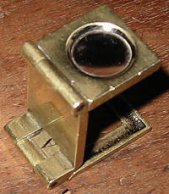
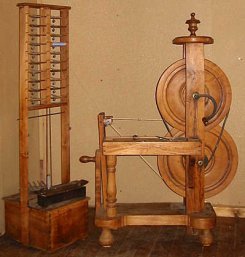
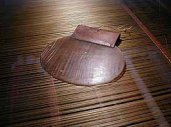

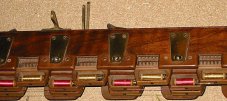

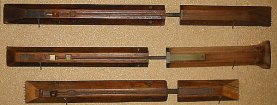
Here are the only types of scissors used by the silk weaver. These are the "Forces".
At the top, classical thread scissors.
Below velvet thread cutter, used to regulate the height of velvet cut pile .
The thread cutter, thanks to their system of spring, are very practical, because they are held in the palm of the hand, without hampering this one in its action. We do not lay down the thread scissors but we keep them in hand without embarrassment.
If there is a tool a weaver is never without, it is this one.
The thread counter is the indispensable tool for the weaver to analyze a fabric or check the number of weft to the centimeter.
The Rouet Lyonnais, here accompanied by its creel, was the winding used before the emergence of electricity. This model, of which the exact date is unknown, existed already strictly in this form before the french Revolution. It has 2 large wheels. The first, moved by hand by its crank, carries the second, which in turn drives the spindle supporting the wooden pirn. By means of these two wheels an important gear is obtained, a crank turn thus winding several meters of thread on the wooden pirn.
The wooden handle shown at the far left is the end of a wooden screw that adjusts the tension of the second belt.
The horn, brass or tin polisher was used to polish certain silk fabrics as weaving. It gave it more gloss and especially more coverage, thus improving fabrics that were not of the best quality ...
Here are two knives for velvet grooved wires, used in the handmade silk cut velvet.
Equipped with a sharp blade, the knife is guided along the grooved wires, across the fabric. Its blade is engaged in the thin groove of the wire, it slices the loops of the pile and thus transforms them into tufts of pile.
The broacher is a tool that fits on a hand loom batten and allows, in silk, to broach a fabric thanks to small shuttles moving on a rack controlled by hand by the weaver. The model presented here has three sets of 9 shuttles each, ie 27 shuttles. The passage of each series of shuttles is controlled manually by the 3 brass handles that are seen at the top of the broaching machine.
Here are 3 temples used in the weaving of hand silks.
The temple is a tool that makes it possible to fight against the pull exerted by the weft on the edges of the fabric.
The temple is stretchable to fit the width of the fabric. Each end has a serie of very sharp needles that are planted in the edge of each edge of the fabric.